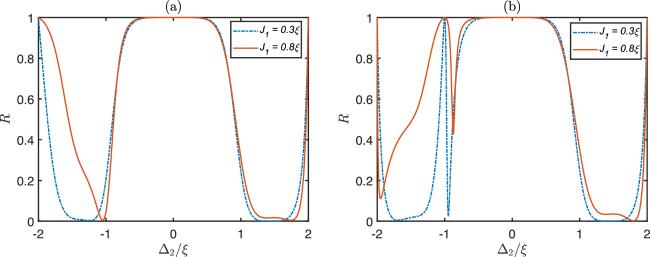As shown in figure
2, we plot the photonic reflection rate for
N = 2, 3, 4, respectively. For
N = 2, the incident photon will be completely transmitted when it is resonant with the bare frequency of the resonators in the waveguide. However, we observe in figure
2(a) that it is reflected. Furthermore, the width of the reflection peak at Δ = 0 is independent of the coupling strength between the giant atom and the waveguide. In contrast, this coupling plays a significant role for
N=3,4, in which case the small atom induces the complete reflection near the regime of Δ = 0. For the case of
N = 3, the giant atom gives birth to a Lamb shift, which is verified by the reflection rate in the regime of Δ < 0 with a relatively larger
J2, as shown in figure
2(b). On the other hand, when the small atom couples to the waveguide stronger than that of the giant atom (
J1 = 0.4
ξ,
J2 = 0.2
ξ), we find a deep valley, which is accompanied by an asymmetric Fano shape. Moving the case of
N = 4, both the small and the giant atoms will reflect the resonant incident photon as shown in figure
2(c). Here, the giant atom coupling actually widens the reflection peak and is beneficial to construct the photon device.







